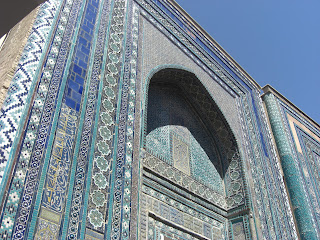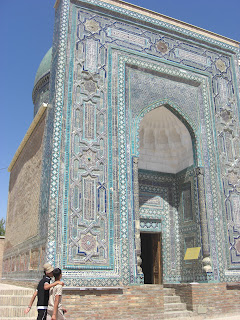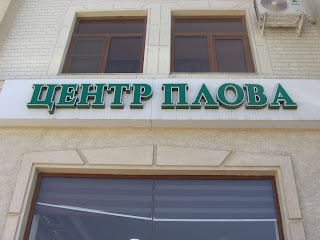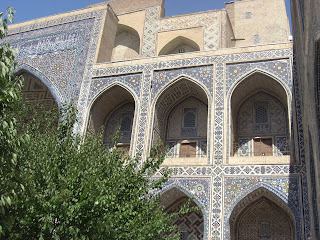Samarkand
The truck was due to leave Bukhara at 7.30am and it was expected to arrive ib Samarkand, our next city stop, in the early afternoon sometime after 2pm. John and I decided to have a day off the truck and take the train fron Bukhara to Samarkand. One small issue was the train tme. It departed at 5.30am which meant getting up at 4am and missing breakfast. It was anearly start but would give us a full day in Samaskand.
We were dressed and packed ready for the taxi to take us to the train station 15 kilometres away.
The train.The signal box.
The journey was largely through flat, featureless, desert.
Only when we were getting close to Samarkand were there irrigation canals and rolling scenery full of trees and green fields. After two and a half hours, we arrived in Samarkand, Uzbekistan's second largest city after the capital, Tashkent. We dropped our luggage at the hotel and hired a guide with a car to explore Samarkand.
A map showing how large the empire Timur created covering parts of three continents
Writing was originally on animal skin until the art of paper making was introduced from China in the 8th century. Samarkand became a najor paper making area. The secret of silk manufacturing also passed along the Silk Road and Samarkand became a major silk producing area.
Ulukbeg was not just a great king that ruled for 35 years, he was also a scientist. He built a 40 metre high observatory and calculated the length of a year to within one minute. He also charted more than a thousand stars. Little of the oryginal building survives.
The entrance to the last surviving part of the observatory
The guide drove to Shakhi Zinda, a collection of mausoleums of famous people and relatives of Amir Timur. The entrance.
...and lots of archetecture and decorations...
... a detail of the roof...
...steps up to the main thoroughfare...
...an unusual double dome...
...a detail of an entrance...
...the main route...
...more elaborate decorations...
...etensive use of gold...
...inside one of the mausoleums...
...unusual decoration as red has been included in addition to the standard predominance of white and blue...
...another view of the mausoleum...
The last stop was the Registan, where there are three ancient madrassas facing each other.
A view of the decoration of one of the domes although this is an optocal illusion as te roof here is in fact flat.
...more views of the nadrassas...
Typical of the style found in Uzbekisatan. The material used indicated her social status and wealth of the family ranging from cotton, through silk to Kashmir. The embroidery on the lapels showed her age within a couple of years. The two long tails from the side or from the head showed whether she was married, spoken for, or single divorced or widowed.
Only when we were getting close to Samarkand were there irrigation canals and rolling scenery full of trees and green fields. After two and a half hours, we arrived in Samarkand, Uzbekistan's second largest city after the capital, Tashkent. We dropped our luggage at the hotel and hired a guide with a car to explore Samarkand.
Our first stop was the Ulukbeg Observatory. He was a grandson of Amir Timur, who along with Alexander the Great and Genghis Khan, became infamous as they fought their way across central Asia. Timur was born nearby to the city.
The doorway of the observatory.
Inside was a map showing several of the Silk Road routes with Samarkand at the centre where the main route in yellow is crossed by a minor route in red.A map showing how large the empire Timur created covering parts of three continents
Writing was originally on animal skin until the art of paper making was introduced from China in the 8th century. Samarkand became a najor paper making area. The secret of silk manufacturing also passed along the Silk Road and Samarkand became a major silk producing area.
Ulukbeg was not just a great king that ruled for 35 years, he was also a scientist. He built a 40 metre high observatory and calculated the length of a year to within one minute. He also charted more than a thousand stars. Little of the oryginal building survives.
The part of the original observatory that survives. It was spared from earthquakes and demolition as this section was underground.
The guide drove to Shakhi Zinda, a collection of mausoleums of famous people and relatives of Amir Timur. The entrance.
...and lots of archetecture and decorations...
... a detail of the roof...
...steps up to the main thoroughfare...
...an unusual double dome...
...a detail of an entrance...
...the main route...
...more elaborate decorations...
...etensive use of gold...
...inside one of the mausoleums...
...unusual decoration as red has been included in addition to the standard predominance of white and blue...
Next stp was the museum and archalogical site of Afrosiab, a civilisation dating back more than 2,750 years until it was destroyed but only discovered in the last few decades.
After lunch, we visited the Amir Temur mausoleum with its distinctive ribbed dome.
...another view of the mausoleum...
...some gold decoration inside.
A view of the decoration of one of the domes although this is an optocal illusion as te roof here is in fact flat.
...more views of the nadrassas...
Typical of the style found in Uzbekisatan. The material used indicated her social status and wealth of the family ranging from cotton, through silk to Kashmir. The embroidery on the lapels showed her age within a couple of years. The two long tails from the side or from the head showed whether she was married, spoken for, or single divorced or widowed.
















































No comments:
Post a Comment